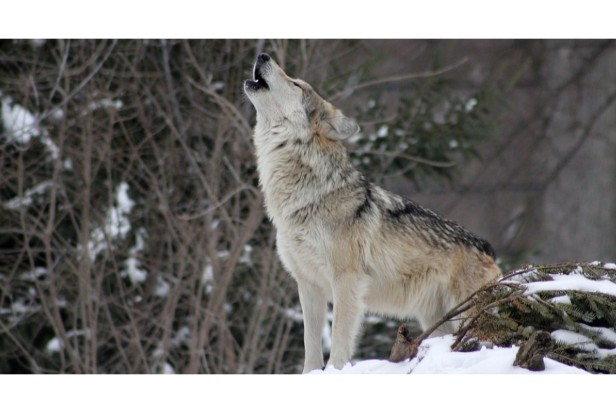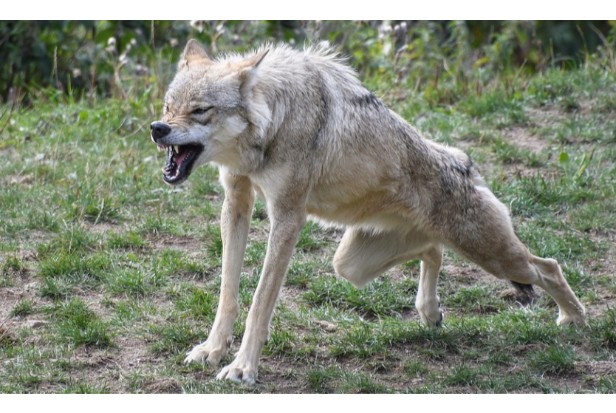The answer to the seemingly straightforward question of “do wolves bark?” is trickier than you might imagine. Technically, wolves are able to bark. The barking we hear from our more domesticated canines may not be the same as this, though. So what does a wolf bark sound like? And why exactly do they do it? What makes it different from a dog’s bark?
To answer these questions and more, we need to dive into the depths of wolf communication, the evolution of domestic dogs, and the “why” behind barking.
Table of Contents
Can Wolves Bark?
This query has a somewhat convoluted solution. Yes, technically, wolves can bark, but their bark is not the same as the bark of your family dog.
Wolves typically reserve their barking for when they are alarmed, and it sounds more like a short, sharp yelp than the prolonged “woof” of a dog.
In addition to howling, whimpering, and growling, wolves also use their bark to express their emotions.
Do Wolves Bark Like Dogs?
Despite the fact that both dogs bark, as you can see, their causes of barking are very different. How did this variation arise? Researchers have found that vocalization in many mammals is closely related to the social group they are in. When viewed in this light, it becomes possible that teaching at a young age is the only way to learn the significance of various vocalizations.
A wolf may only bark in particular situations because it has trained itself to do so only in those situations. In one study, the social behavior patterns of dogs were investigated. This study coined the term “social selection” to describe the phenomenon of social pressures in highly social species.
Simply put, wolves who are better at effectively communicating with their pack mates have a higher chance of surviving. After all, it is crucial to be able to communicate with your fellow hunters while on a hunt. Therefore, it is likely that wolves who learned effective communication from their parents had a high chance of surviving, reproducing, and passing on that ability to their own pups.
This explains why communication between generations of wolves is typically consistent. The genetic and biological aspects of vocalization are of course not diminished in any way. Animals with the ability to bark include wolves and dogs. Contrarily, humans are unable to. As a result, vocalization depends in part on genetics and in part on the environment and social group of the individual animal.
What’s the Difference Between a Wolf and Dog Bark?
Wolf barking differs from dog barking. They don’t actually sound like dogs when they communicate because their barks are lower-pitched. Additionally, they frequently communicate through a series of howls that resemble barking.
Usually louder and higher pitched dog communications. Each bark is brief and distinct. When wolves huff, they appear to be about to let out a full-on bark, as opposed to barking as some pet dogs might. They simply never seem to arrive there.
However, a wolf’s howl sounds a lot like a dog’s. A pack of howling dogs may occasionally be mistaken for a pack of wolves when heard at night. You might mistake a howling wolf for a dog. Therefore, if you see something howling at you from a distance, it’s critical to determine whether you’re dealing with a dog or a wolf. It’s best to move slowly in the opposite direction if you are unsure.
The Relationship Between Wolves and Dogs
The domestic dog (Canis Familiaris) is a direct descendant of the gray wolf (Canis lupus). After being bred by humans for thousands of years for various purposes, including hunting, herding, and companionship, modern dogs are what we see today.
Even though dogs and wolves are closely related, they have evolved into very different animals.
Their appearance is where the most obvious difference can be seen. Wolves are much larger than most dogs, with males weighing an average of 180 pounds and females weighing an average of 130 pounds. Additionally, they have larger feet, larger muzzles, longer legs, and more streamlined bodies.
Wolves have a thicker double coat than dogs, which helps them better withstand the cold.
Dogs, on the other hand, come in a wide variety of sizes and shapes because there are so many different breeds that have been developed.
Along with temperament, wolves and dogs exhibit very different behaviors and temperaments. For instance, wolves are much more independent and prefer to stick to their own pack while dogs are naturally social animals that enjoy the company of people and other animals.
Dogs are much more suitable as pets because they have been bred to be less aggressive than wolves.
Read more: When Do Puppies Start Barking? (Ways to Stop It) – Everything Pets

Vocalizations of Wolves and What They Mean
When communicating with their pack and one another, wolves make a variety of vocalizations. The most famous wolf vocalization, which has several purposes, is probably howling.
Howl
The only method of communication used by wolves that are meant for long distances is howling. A defensive howl is used to defend kill sites, to stand their ground and protect young pups who can’t yet escape danger, to keep the pack together, to keep strangers away, and to keep the pack together while keeping strangers at bay. A social howl is used to find each other, form a group, and possibly just for amusement.
Growl and Snarl
Growls can be used as a warning signal and can be directed at humans or other animals. Another indication of aggression or dominance is a growl.
Growls and snarls are similar sounds, but growls are typically louder and accompanied by bared teeth. This is an unmistakable indication that the wolf feels threatened and is getting ready to attack.
Whimper
Lower-ranking pack members frequently whimper to the alpha to let him or her know they are not a threat because it is a sign of submissiveness or fear. When hurt or distressed, adult wolves will also whimper.
Yip
A yip is a brief, high-pitched vocalization that serves a variety of functions. Puppies yip to play or attract their mother’s attention.
Adult wolves will also yip when they are happy or excited, such as when greeting a pack mate.
Whine
An expression of disappointment or distress, whining is a low, plaintive vocalization. For instance, when a wolf is hungry or hurt, it may whine.
Bark
Wolves do bark, as we’ve already mentioned, but their howls are not at all like dog howls. Typically, wolves only bark when they are startled or feel threatened.
The sound is more like a short, sharp yelp than the prolonged “woof” of a domestic dog.
Other Forms of Wolf Communication
Despite the fact that wolves’ vocalizations appear to be quite descriptive, they are unable to convey the depth of communication needed for courtship, territory claim, aggression, parenting, etc.
In addition to urination, scat, pheromones, and body language, wolves also communicate with one another by urinating.
Urination
To mark their territory and leave their scent, wolves will urinate on trees, rocks, and other tall objects. The alpha male and alpha female of the pack typically do this to signal to other wolves that this territory is theirs.
Scat
Wolves also use scat to leave their scent and mark their territory. Additionally, it can be used to speak to other wolves.
Pheromones
Like all animals, wolves use pheromones to communicate. These are chemicals that are discharged into the atmosphere and can transmit a number of messages, including the availability of mates.

Body Language
Wolves communicate with one another by using body language. To demonstrate submission or dominance, they might, for instance, hunch their shoulders and lower their bodies.
Other facial expressions that wolves use to express their mood include showing their teeth.
FAQ
1. Do Wolves Attack Humans?
Like many large carnivores, wolves tend to be frightened of people and will stay away from them, as well as from structures and roads. The risk of wolves attacking or killing people is low. It is best to avoid feeding wolves and maintain a respectful distance from them, as with other wildlife.
2. Wolves Don’t Make Good Pets
However, these wild animals do not develop into endearing human companions, despite a small research study suggesting that wolf pups raised by humans can become attached to them. They haven’t been domesticated for as long as dogs over thousands of years.
Final Thoughts
Although wolves may have a genetic affinity for dogs and frequently resemble dogs, they are not dogs and should never be handled as such. We humans should always heed the warnings given by wolves whenever they make any kind of noise.
Read more: Can Coyotes Jump Fences? (Tips to Keep Them Away) – Everything Pets
Why Do Huskies Scream So Much? Howling And Barking As Well – Everything Pets
